It looked like robots of the past
Even in antiquity people watching nature, I wanted to join with her in the competition and learn how to give birth to creatures that are indistinguishable from those made of flesh and blood. Researches philosophers, engineers and even jewelers and illusionists past anticipated the emergence and development of modern robotics.
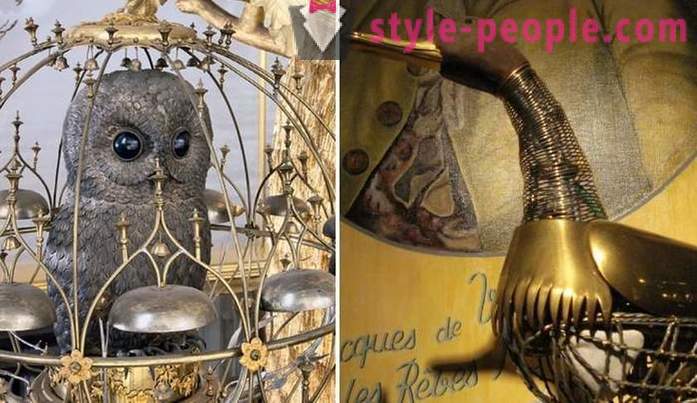

Sofia, the world's first humanoid robot, created in 2015.
From wood pigeon to artificial man
The Roman writer Aulus Gellius mentioned that Greek commander and Pythagorean philosopher Archytas, "sophisticated, inter alia, in the mechanics," fashioned out of wood pigeon, which flew about two hundred meters. Among the spectators were delighted and children, for which earlier this statesman, successfully defend against invaders, invented a rattle.
Trud "Pneumatics" other ancient scientist, Hero of Alexandria, mechanics and engineers used until the XIX century. Through the development of Gerona in 1832, it was designed in the unique astronomical clock in Strasbourg Cathedral, showing the movement of the planets.
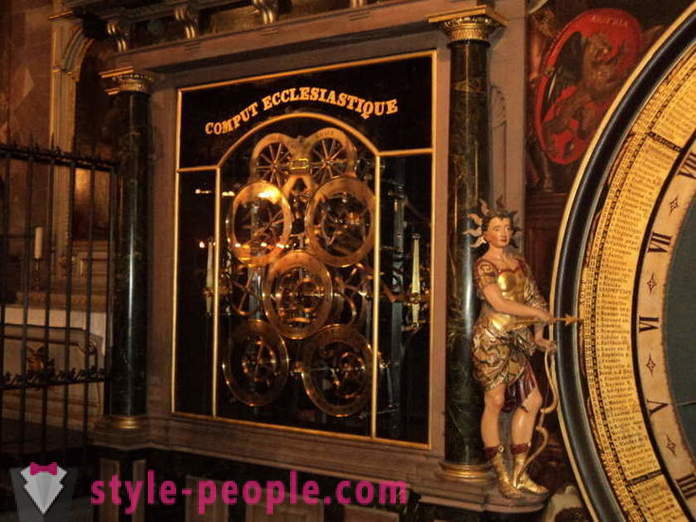
Astronomical Clock Strasbourg Cathedral.
Medieval Arabic inventor Al-Jazari in the XIII century, was designed, among other things, the jukebox: Four mechanical dolls, which floated in a boat on the lake, playing cymbals and drums.
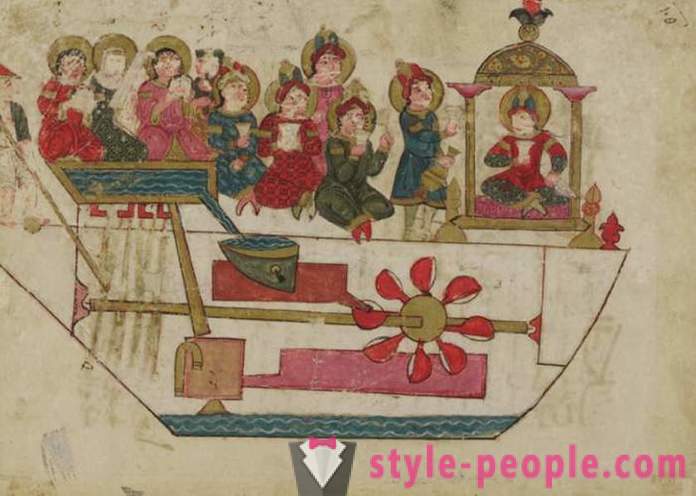
Mechanical musicians. Illustration al-Jazari to his 1206 treatise "The Book of knowledge of ingenious mechanical devices."
In Christian Europe, daring and sinful, it would seem, thoughts of creating an artificial man nurtured in the monastic cells. Keep a job, learned monks Villard de Honnecourt and Raymond Lully. Albertus Magnus, according to legend, it was possible to create the "Iron Man", but a masterpiece spoiled student Magnus - the future philosopher-theologian Thomas Aquinas.
The mechanical knight Leonardo da Vinci and the "iron man" Ivan the Terrible
Leonardo da Vinci and Galileo as Archytas without mechanical brezgovali invention trifles for children. For King Francis I of Leonardo did a great toy: walking, opening the mouth, waving tail, and is cast out of the womb lily lion.
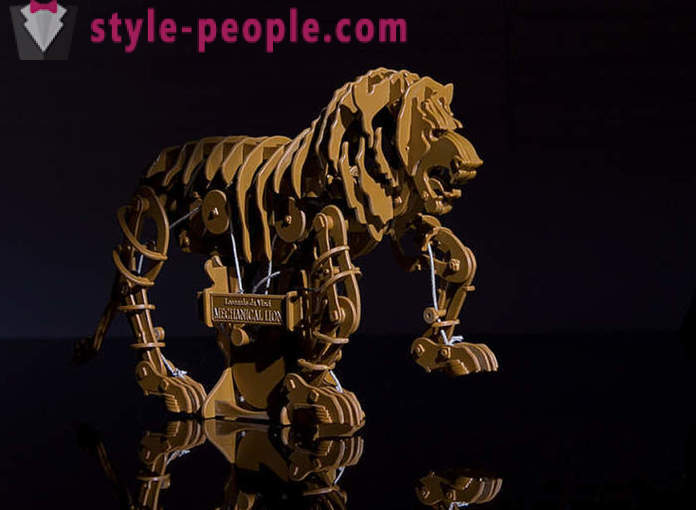
A mechanical lion Leonardo da Vinci. Modern reconstruction.
But the most cherished ideas of da Vinci's left in his drawings. Among them was the "mechanical knight", which was supposed to move the limbs, turning his head and lifted his visor.
Foreign merchants who had a chance to feast at the court of Ivan the Terrible, was told that the Russian Tsar was a strange game, "iron man", ministered to the owner and to the delight of guests who had fought with the bear. When one of the merchants suspected that hidden people live within the metal shell, the king ordered the artisans to disassemble "the guy." Wonder foreigners who saw the springs and gears, really liked the king, and he said that in Russia such "wonder" vodilas three hundred years ago. Figure out cunning Ivan the Terrible or not, scientists have not yet happened.
Mechanics and jewelers, do not set ourselves ambitious goals for XV-XVII centuries, improved in the creation of the precious "trifles". Such, for example, are leaving on the table jukebox while a vessel for wine "Triumph of Bacchus".
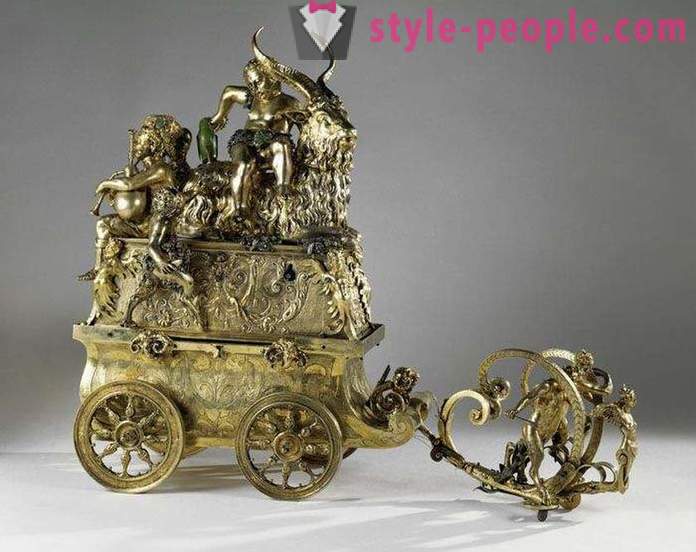
"Triumph of Bacchus". Germany, the beginning of the XVII century. Vienna, Hofburg Palace, the Habsburgs Treasury
automatons XVIII century: the musicians, august persons and ferocious predators
It is believed that a revolution in the art of creating artificial beings, sometimes frighteningly similar to the living, has made a French inventor Jacques de Vaucanson. He also introduced the fashion public demonstrations automatons. In the 1730s Vaucanson spoke to Parisians and Londoners are not just entertaining but also educating them as displays of mechanical marvels were accompanied by lectures about the structure and mechanism of action. More than the other three known works Vaucanson "Flutist", which the author has awarded a separate booklet, "Tamburinschik" and "Duck", "training" to drink water, peck grains and defecate.
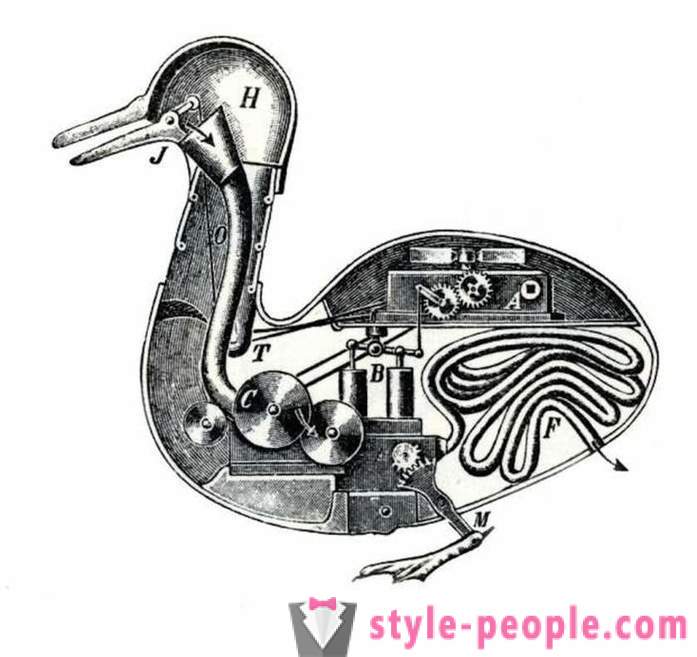
"Duck" Vaucanson. Driving device.
Swiss Pierre Jaquet-Droz went down in history as a skilled watchmaker, a pioneer in his craft. He founded the brand still exists today. But first he has become famous as the creator of automatons. Three most famous mechanical people - "musician", "Draftsman" and "clerks" - sometimes referred to as the first robot. They Jaquet-Droz traveled to Europe and was well received at the royal courts.
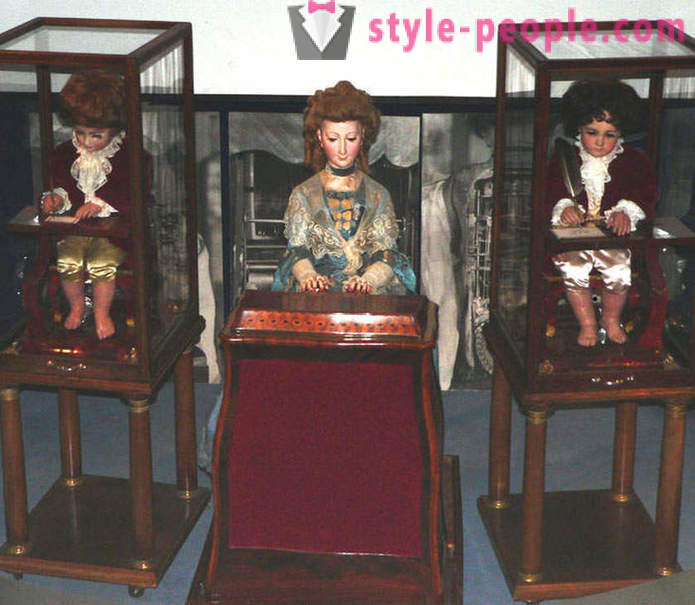
"clerk", "draftsman" and "musician" by Pierre Jaquet-Droz. Switzerland, in 1774.
"Musician", alternately playing the flute body five of their tunes, They looked right and left. Artificial girl leaned to the instrument, and her shoulders heaved from "breathing". A separate mechanism is set in motion by flexible fingers.
But the most complex automaton of the trio was "clerk" - a boy who could have dipped the pen in the ink, write on a piece of paper of any text, not to exceed 40 characters. The second boy, "draftsman", copying the image thumbnail. In particular, the painted portraits of French kings - the late Louis XV and Louis XVI c Welcome wife. The three of them automatons royal couple saw in Paris in 1775.
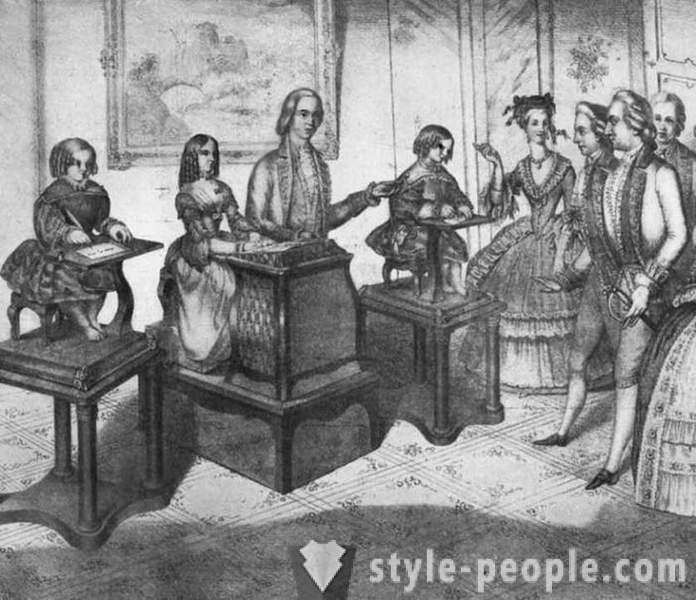
Lithography XVIII century. Pierre Jaquet-Droz introduces King Louis XVI and his creations.
One of the treasures of the Hermitage in St. Petersburg - a luxury watch "Peacock" working until now. Prince GA Potemkin ordered them from the James Cox, a mechanic and a jeweler, the owner of the museum of strange machines in London. By assembling and restoration of Cox's masterpiece and the best of his assistants Friedrich Urey had a hand in Russian craftsman Ivan Kulibin. "Peacock"
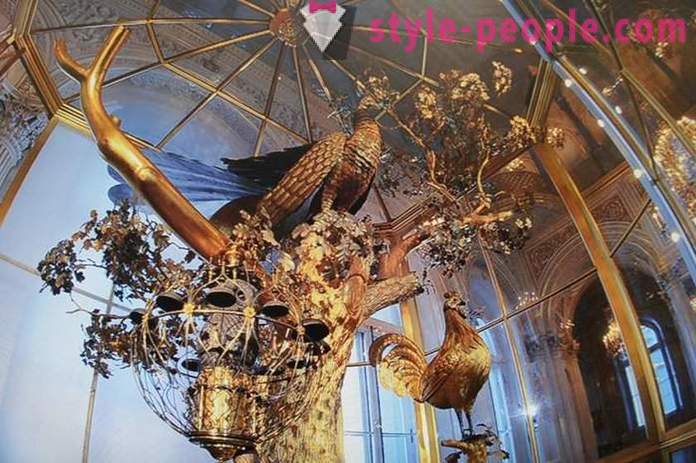
Clock. J.. F. Cox and Urey. United Kingdom, the end of the 1770s - beginning of 1780s. St. Petersburg, The State Hermitage Museum / Photo:. S3.fotokto.ru
Kulibin himself back in 1769 he presented to Catherine II miniature in comparison with "Peacock", but not inferior to him in difficulty clock "egg shape". In their tiny house was built, in which the jewelry crafted "actors" played representations of biblical scenes.
In 1799, during the colonization of India, British troops stormed the palace of Tipu Sultan, ruler of Mysore State. With amazement invaders automaton saw wood, in the nearly full-size depicting tiger that tore officer English. In the body of the beast has been let into a mechanical body, imitating the moans of the dying.
"Tiger Tipu" served as a kind of symbol maysurtsev independence. Its creators inspired by a real incident: which ended unsuccessfully hunting Hugh Monroe lieutenant.
Children's toys clockwork industrial production
At the turn of XIX-XX centuries, when mechanical toys began to be manufactured industrially produced, they finally fell into the hands of children. Now such joy could give your child and relatively poor parents.
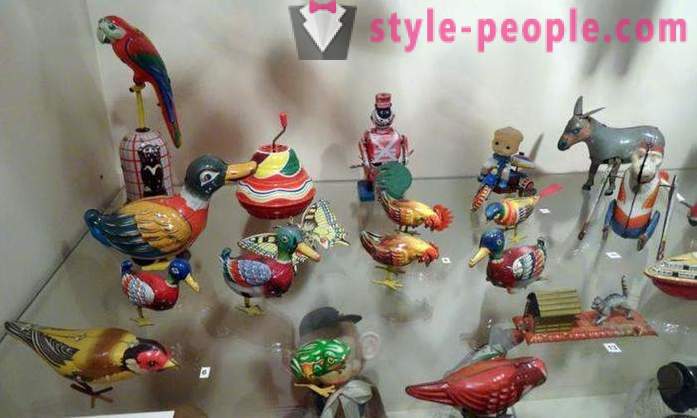
The German and Japanese mechanical toys from the collection of the St. Petersburg Museum of toys.
In the USSR, clockwork toys started to produce the industrial way in the 1930s. This was done in Moscow Artel "Shtampigrushka" at Univerprome and "KIM". Also, mechanical toys and games made in special workshops of heavy industry waste products, in particular at the "North press" in Leningrad and "Press" in Serpukhov.
In the 30 same, more precisely, in 1932, Japanese engineers have designed the first robot, and in this case the interests of scientists and children in line. 15-inch "The Lilliput", "who could" walk different futuristic design.
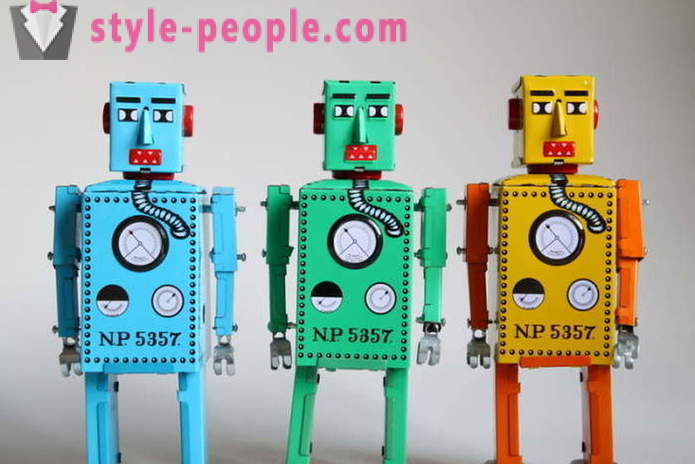
Modern toy robots - a copy of the Japanese robot "Lilliput" in 1932.
After a few centuries, the robot will be one of the most popular toys. But the kids wound up 30th in the main key rather primitive cars, but the Soviet children - even small tractors.
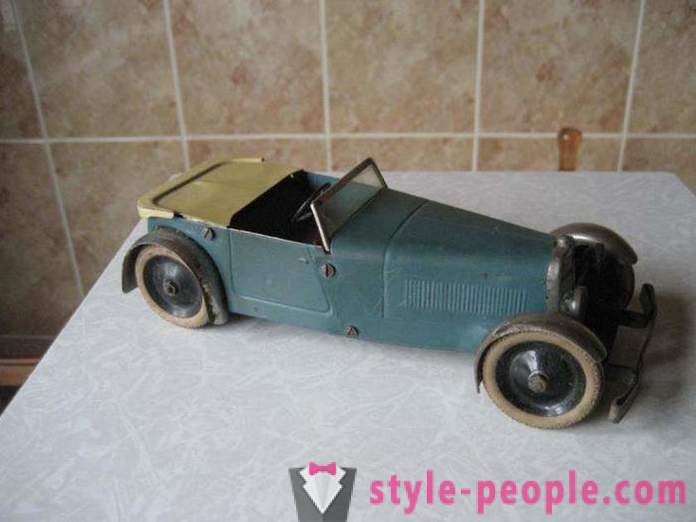
Prewar groovy car made in Leningrad.
In the 50s in large quantities produced tin frogs, ducks, chickens, canaries. Birds bent as if pecking grain. They slightly resemble its ancient prototype of "Duck" Vaucanson, although plausible eat and drink could not.
More complex in design and construction, but also more expensive toys are on the theme of the circus and popular in the 50's - 60's.
About 60 resemble plush and old clockwork toys: bears with honey keg, balalaika or Khokhloma wooden spoon, monkeys, dogs. They are soft to the touch, although the frame still remained tough.
In the 80s the interest in clockwork toys was gradually lost. But in recent years he has returned, despite all the variety on the shelves and children's stores.
However, today the mechanics do not get tired to surprise the audience.













































